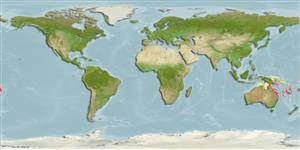Actinopterygii (ray-finned fishes) >
Tetraodontiformes (Puffers and filefishes) >
Monacanthidae (Filefishes)
Etymology: Paramonacanthus: Greek, para = the side of + Greek, monos = one + Greek, akantha ) thorn (Ref. 45335).
Environment / Climate / Range
Ecology
Marine; demersal; depth range 0 - 78 m (Ref. 33065), usually 20 - 78 m (Ref. 33065). Tropical, preferred ?
Southwest Pacific: east coast of Australia from Lizard Island in north Queensland to Sydney Harbor in New South Wales. In addition, two specimens have been collected at the Chesterfield Reefs, about 900 km off the coast.
Size / Weight / Age
Maturity: Lm ? range ? - ? cm
Max length : 13.9 cm SL male/unsexed; (Ref. 33065)
Dorsal
spines
(total): 2;
Dorsal
soft rays
(total): 27-30;
Anal
spines: 0;
Anal
soft rays: 26 - 28;
Vertebrae: 19. Dorsal profile of snout moderately to slightly convex in male, usually straight in female, without prominent hump just before nostrils; soft dorsal fin of male with second ray elongate and filamentous; no elongate rays in caudal fin; narrow whitish lines often along body; dark stripe on outer margin of anal fin in male, width equal to or greater than width of pupil.
Life cycle and mating behavior
Maturity | Reproduction | Spawning | Eggs | Fecundity | Larvae
Hutchins, J.B., 1997. Review of the monacanthid fish genus Paramonacanthus, with descriptions of three new species. Rec. West. Aust. Mus. Suppl. No. 54:1-57. (Ref. 33065)
IUCN Red List Status (Ref. 115185)
CITES (Ref. 94142)
Not Evaluated
Threat to humans
Harmless
Human uses
More information
Common namesSynonymsMetabolismPredatorsEcotoxicologyReproductionMaturitySpawningFecundityEggsEgg development
ReferencesAquacultureAquaculture profileStrainsGeneticsAllele frequenciesHeritabilityDiseasesProcessingMass conversion
Tools
Special reports
Download XML
Internet sources
